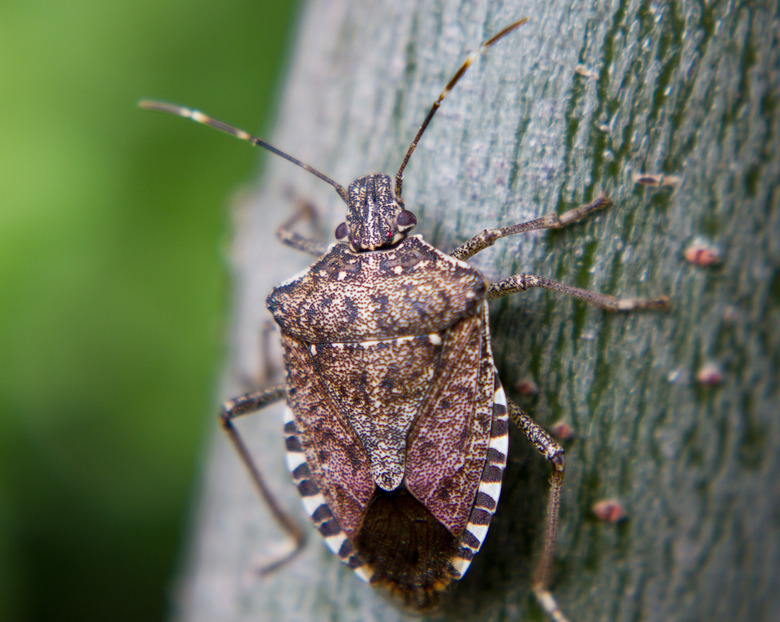The Life Cycle Of A Stink Bug
They're creepy when they buzz loudly past you towards light sources and produce an extremely pungent odor when disturbed, but stink bugs live their lives content to feed on plants and would rather not encounter you. If that feeling is mutual, gaining an understanding of their life cycle will help you know how to avoid them whenever possible. Stink bugs start out as eggs, progress through a nymph stage and then move on to adulthood. Together, these different growth phases form a stink bug's life cycle. Many other insects share a similar life cycle to the stink bug, including bed bugs, cockroaches, termites and lice. Although an agricultural pest, stink bugs don't feed on humans or cause property damage to homes at any stage of life.
Eggs
Eggs
Up to three generations of stink bugs are produced each year, and it all starts with a bit of summer love. For stink bugs, romance is in the air from May through August, during which time they mate. After mating, the female lays batches of 20 to 30 eggs, depositing them on the underside of plant leaves. Her eggs look like tiny barrels and are light green in color to blend in with their surroundings and avoid predators. The eggs hatch in four to five days, marking the beginning of the nymph stage.
Nymphs
Nymphs
After hatching, young stink bugs are known as nymphs. Nymphs go through five stages of development called instars. Each of these stages is essentially a growth spurt since a nymph's exoskeleton can't grow along with the young insect. Instead, nymphs must shed their restrictive outer layer of skin in order to grow in size. Entomologists refer to this process as molting.
Each instar lasts about one week. During the first instar, the nymphs are about 2.4 millimeters long, wingless and an orange-red in color. In the second, the nymphs darken in appearance and take on a coloration very similar to the one they'll have as adults. The nymph will continue through three more instars, each time shedding their old skin and increasing in size. During the final instar, the nymphs get their wings and grow to a length of about 12 millimeters.
Adults
Adults
Upon reaching adulthood, stink bugs spend their lives feeding on plant materials, mating and looking for warm spots to hide from winter weather. It's often when these insects look for a cozy winter hideout that humans encounter them. Stink bugs will use any available crack or gap to crawl inside your warm home and live there until either spring arrives or they encounter an angry human who hastens their demise. Adult insects are able to mate just two weeks after entering adulthood and typically live for 50 days to about eight months, depending on which of the 5,000 stink bug species they belong to.
Getting Rid of Them
Getting Rid of Them
Getting rid of stink bugs requires a two-pronged approach that thwarts them both inside and outside of your home. Your first line of defense is to try and keep them away from your lawn and garden. In the spring and summer, insecticidal oils, soaps and broad-spectrum insecticides like pyrethrin and azadirachtin can kill eggs and nymphs on garden plants. You'll also help yourself if you avoid plants that attract stink bugs in your garden. Attractant plants commonly used in landscaping include boxelder (Acer negundo), butterfly bushes (Buddleja spp.) and English holly (Ilex aquifolium). During summer months, try to avoid using outdoor lights located close to doorways. The lights attract the insects who may enter your home along with you.
Your second defensive action is to exclude stink bugs from your home so they can't overwinter there. To keep the insects out, spend the fall replacing torn window screens, installing weather stripping and screening vents. Seal any gaps in your home's foundation or exterior walls as well, paying particular attention to cracks around window and door frames.
If, despite your best efforts, you're still living with stink bugs, consider calling a professional exterminator for help.
References
- Orkin International: Stink Bug Life Cycle
- Terminix International company, LP: Stimk Bugs Life Cycle
- Orkin International: How to Get Rid of Stink Bugs
- University of California Statewide Integrated Pest Management Program: Brown Marmorated Stink Bug
- Stop BMSB: Host Plants of the Brown Marmorated Stink Bug in the U.S.
Cite This Article
MLA
Miley, Michelle. "The Life Cycle Of A Stink Bug" sciencing.com, https://www.sciencing.com/the-life-cycle-of-a-stink-bug-12000125/. 23 August 2018.
APA
Miley, Michelle. (2018, August 23). The Life Cycle Of A Stink Bug. sciencing.com. Retrieved from https://www.sciencing.com/the-life-cycle-of-a-stink-bug-12000125/
Chicago
Miley, Michelle. The Life Cycle Of A Stink Bug last modified March 24, 2022. https://www.sciencing.com/the-life-cycle-of-a-stink-bug-12000125/
